i-80 Gold Expands High-Grade Mineralization in the Hilltop Zones at Ruby Hill
Upper Hilltop Zone: 1.7 g/t Gold, 421.3 g/t Silver, 6.9 % Zinc, & 19.8 % Lead over 15.2 meters and 25.3 g/t Gold, 848.0 g/t Silver, & 7.9 % Lead over 7.6 meters
Lower Hilltop Zone: 4.2 g/t Gold, 433.6 g/t Silver, 20.7 % Zinc & 12.4 % Lead over 3.1 meters
Reno, Nevada, February 23, 2023 – i-80 GOLD CORP. (TSX:IAU) (NYSE:IAUX) (“i-80”, or the “Company”) is pleased to report continued high-grade poly-metallic results from drilling completed in 2022 and the discovery new CRD mineralization at the recently discovered Hilltop Zones within the Company’s 100%-owned Ruby Hill Property (“Ruby Hill” or “the Property”) located in Eureka County, Nevada.
The Upper, Lower and East Hilltop Zones are three newly discovered Carbonate Replacement Deposit-type mineralization (CRD) zones closely associated with the newly identified Hilltop fault structure located on the south side of the Archimedes pit (see Images 1 & 2). Previously released results from drilling in the Upper Hilltop Zone returned high-grade intercepts including 515.3 g/t Ag, 28.9 % Pb, 10.5 % Zn & 0.9 g/t Au over 28.3 m, 1.9 g/t Au, 631.3 g/t Ag, 7.4 % Zn & 33.0 % Pb over 18.3 m and 60.2 g/t Au, 908.7 g/t Ag, 1.1 % Zn & 15.7 % Pb over 10.0 m (see press releases dated August 30th, 2022 and November 14, 2022), 238.8 g/t Ag, 11.0 % Zn & 9.0 % Pb over 9.4 m in the Lower Hilltop Zone (see press release dated August 30, 2022) and the discovery of the East Hilltop Zone announced just prior to year-end where the first hole testing this target intersected an impressive 12.3 % Zn over 39.6 m (see press release dated Dec. 19, 2022 and Image 1). Results contained in this release are from drilling completed in 2022.
New highlight results from 2022 drilling at Ruby Hill include:
Upper Hilltop Zone
iRH22-42
- 0.8 g/t Au, 461.0 g/t Ag, 7.7 % Zn & 25.9 % Pb over 27.4 m
iRH22-52
- 1.7 g/t Au, 421.3 g/t Ag, 6.9 % Zn, 19.8 % Pb over 15.2 m
iRH22-66
- 25.3 g/t Au, 848.0 g/t Ag, 0.2 % Zn, 7.9 % Pb over 7.6 m
iRH22-70
- 3.0 g/t Au, 121.7 g/t Ag, 0.9 % Zn & 6.9 % Pb over 7.3 m and
- 7.2 g/t Au, 420.1 g/t Ag, 2.8 % Zn & 16.8 % Pb over 6.6 m
iRH22-72
- 2.5 g/t Au, 145.0 g/t Ag, 0.9 % Zn & 8.2 % Pb over 19.8 m
Lower Hilltop Zone
iRH22-39
- 0.8 g/t Au, 779.0 g/t Ag, 15.2 % Zn, 7.1 % Pb & 0.8 % Cu over 1.4 m and
- 0.0 g/t Au, 993.0 g/t Ag, 18.1 % Zn, 39.6 % Pb & 1.8 % Cu over 1.1 m
iRH22-40
- 4.2 g/t Au, 433.6 g/t Ag, 20.7 % Zn, 12.4 % Pb, & 0.6 % Cu over 3.1 m
iRH22-41
- 0.8 g/t Au, 127.5 g/t Ag, 9.4 % Zn & 4.4 % Pb over 5.8 m and
- 1.6 g/t Au, 179.9 g/t Ag, 8.7 % Zn & 7.6 % Pb over 3.7 m
“Ongoing drilling in the new Hilltop discoveries continue to display grades that rank amongst the highest in any new discovery worldwide”, stated Ewan Downie, CEO of i-80. “Three target areas along the Hilltop fault structure were tested by drilling in 2022, all of which intersected polymetallic CRD and/or skarn base metal mineralization. These deposits are located in close proximity to the underground infrastructure being planned in 2023”.
“The 2023 drill program will also test several targets identified in geophysical surveys that are believed to be prospective for CRD, skarn, or porphyry mineralization as we seek to build on our highly successful 2022 exploration campaign at Ruby Hill”, stated Tyler Hill, Senior Geologist of i-80. “In addition to these exciting results, we have yet to test the Hilltop Corridor further south toward our property boundary.”
The Hilltop Corridor is a 1.5 km long, alluvial covered trend immediately south of the Archimedes pit. It is believed to be host to multiple feeder fault structures and is largely untested by previous drilling owing to the alluvial cover. The identification of what appears to be a major northwest striking fault structure that is closely associated with the discovery of the Hilltop Zones confirm the Company’s geological teams’ model that the Ruby Hill Property could be host to multiple types of mineralization and several large-scale deposits. The Upper and East Hilltop Zones appear to be associated with anomalies identified in the Magnetotelluric (MT) geophysical survey along the Hilltop fault structure.
Upper Hilltop Zone
The Upper Hilltop Zone discovery consists of polymetallic-rich CRD that was first drilled in August of 2022. The first core hole drilled returned an impressive 515.3 g/t Ag, 28.9 % Pb, 10.5 % Zn & 0.9 g/t Au over 28.3 m in hole iRH22-43. Follow-up drilling returned results of 1.9 g/t Au, 631.3 g/t Ag, 7.4 % Zn & 33.0 % Pb over 18.3 m in hole iRH22-53 and 60.2 g/t Au, 908.7 g/t Ag, 1.1 % Zn & 15.7 % Pb over 10.0 m in hole iRH22-55 confirming continuity of mineralization located immediately south of the Archimedes pit.
The ongoing step-out drill program is focused on expanding and defining this new zone of with numerous new high-grade intercepts highlighted in Table 1 below. Hole iRH22-66 extends Upper Hilltop high-grade mineralization a further 100 meters northwest. Also listed is hole iRH22-42, a reverse circulation (RC) hole drilled as a twin to iRH22-43 and displays near-identical grades and widths as the intercept is located above the water table. Owing to this confirmation, RC drilling is being performed to complement core for the expansion of the Upper Zone.
Lower Hilltop Zone
The first hole drilled to test the Lower Hilltop target (iRH22-25) was completed in late June of 2022 and intersected high-grade CRD mineralization assaying 238.8 g/t Ag, 11.0 % Zn & 9.0 % Pb over 9.4 m. Multiple zones of flat-lying mineralization occur at Lower Hilltop proximal to the Hilltop fault with mineralized intervals ranging from 0.8 to 9.4 meters wide. Follow-up drilling completed in 2022 intersected bonanza-grade mineralization that remains open in multiple directions – results are presented in Table 1. Additional step-out drilling in the Lower Hilltop Zone is being completed in the current drill campaign.
East Hilltop Zone
Towards the end of 2022, drilling tested for potential mineralization to the south of the Blackjack deposit that is located immediately below the Archimedes pit. The first hole (iRH22-61) intersected high-grade skarn mineralization approximately 450 meters to the south of Blackjack, assaying 12.3 % Zn over 39.6 m. This discovery is interpreted to be along the eastern extension of the newly identified Hilltop fault that is believed to be a controlling structure for mineralization in this area (See Figure 1). The Hilltop fault strikes west-northwest and dips steeply north. Mineralization in the Hilltop area is located proximal to this fault with the largest zones at intersections with other structures. Follow-up drilling is underway and has recently discovered CRD mineralization (assays pending – see Photo 1) in addition to additional skarn mineralization in the East Hilltop target area suggesting the potential for mineralization over >500 meter strike-length proximal to the Hilltop fault.
Geophysical surveys have been completed over the discovery area and have identified several highly-prospective anomalies that are believed to have the potential to represent additional massive sulfide targets. Several of these anomalies will be the tested in the 2023 drilling program and additional RC and core rigs have been mobilized to Ruby Hill to accelerate the advancement of the multiple mineralized zones within the Hilltop Corridor.
Skarn-type mineralization immediately below the Archimedes pit was partially defined by previous owners Homestake and Barrick. This mineralization occurs in the Blackjack target area in close proximity to the Graveyard Flats intrusive complex (see Figure 1) and is being drilled as part of the 2023 program. This target area remains open for expansion both north and south.
Figure 1 – Hilltop Corridor Surface Plan
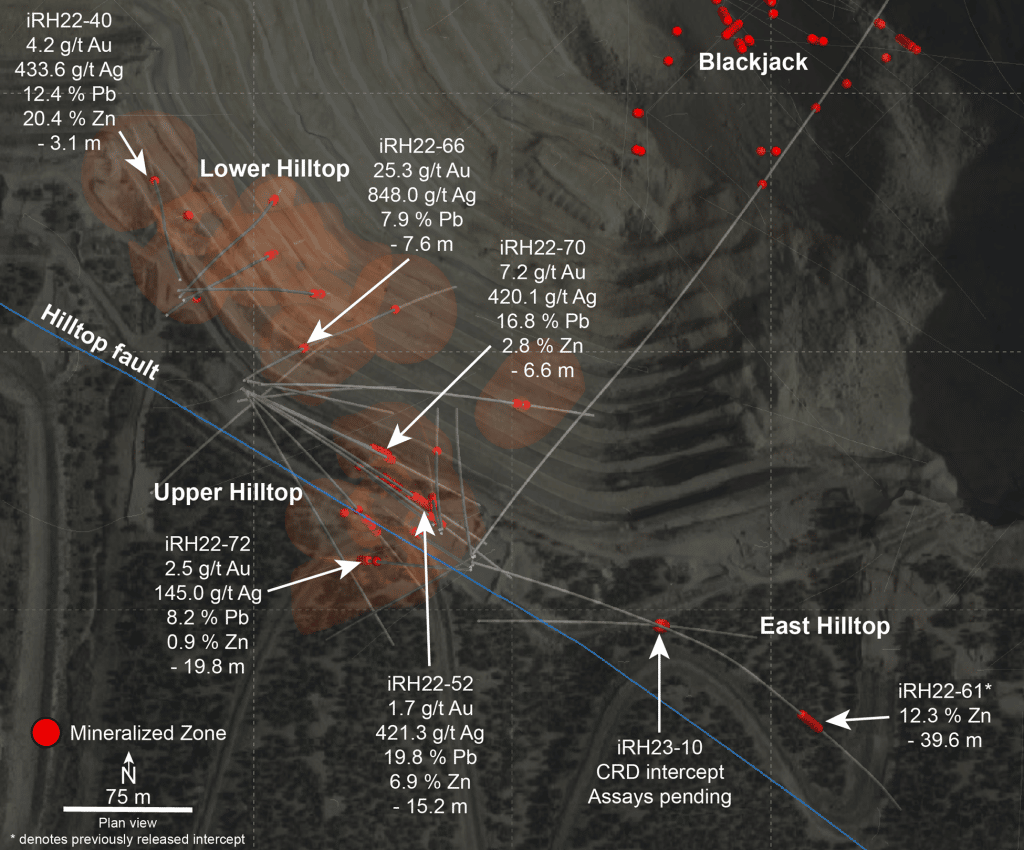
Figure 2 – Cross Section Hilltop Target
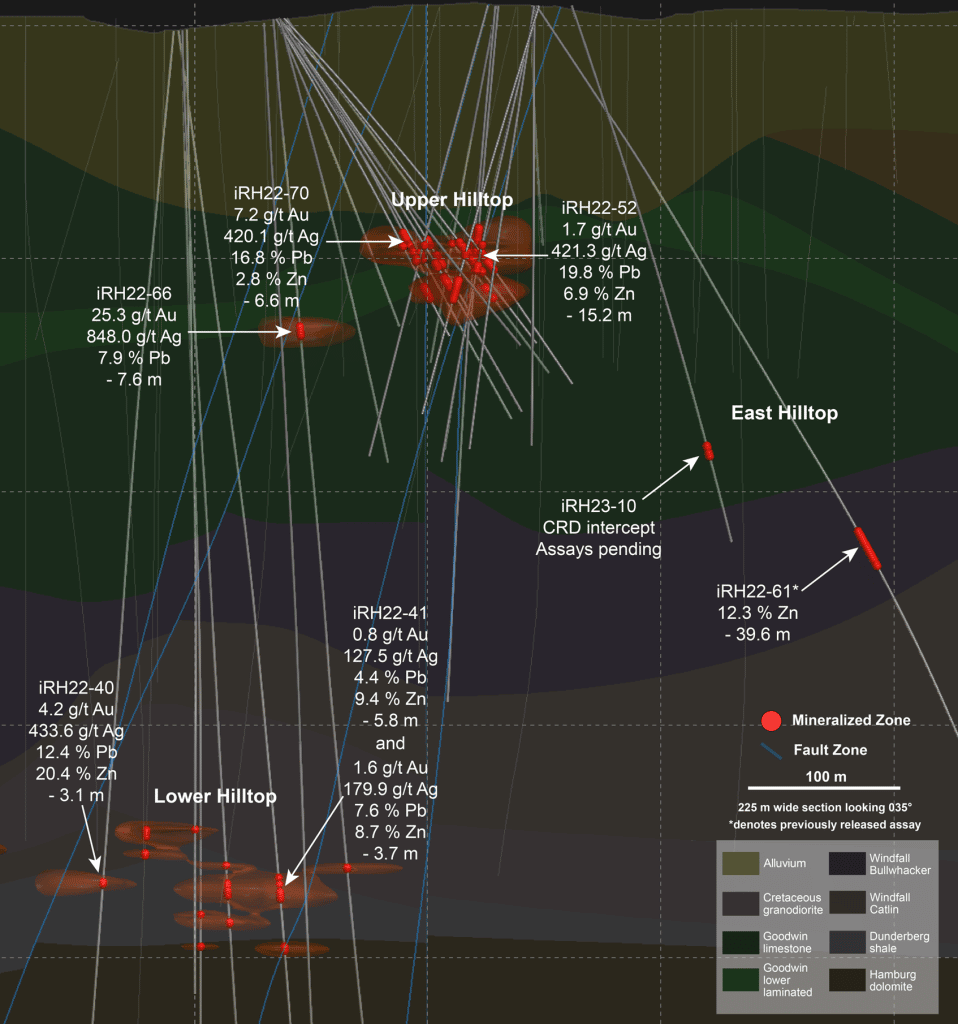
Photo 1 – CRD Mineralization Intersected at East Hilltop in 2023 (assays pending)
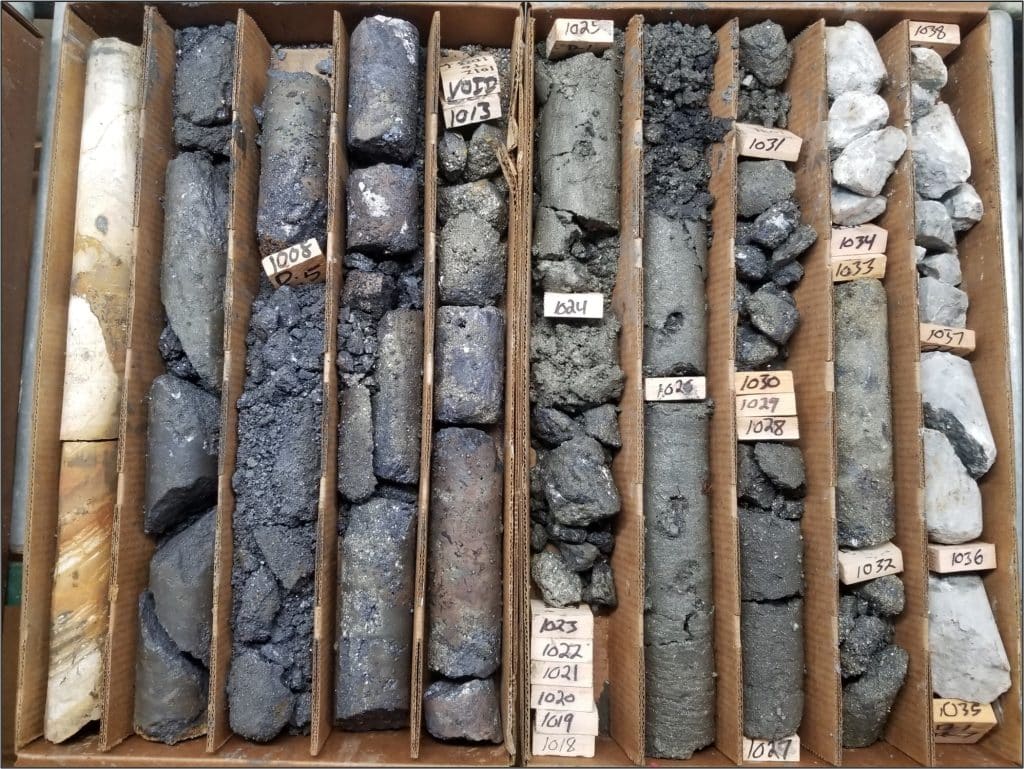
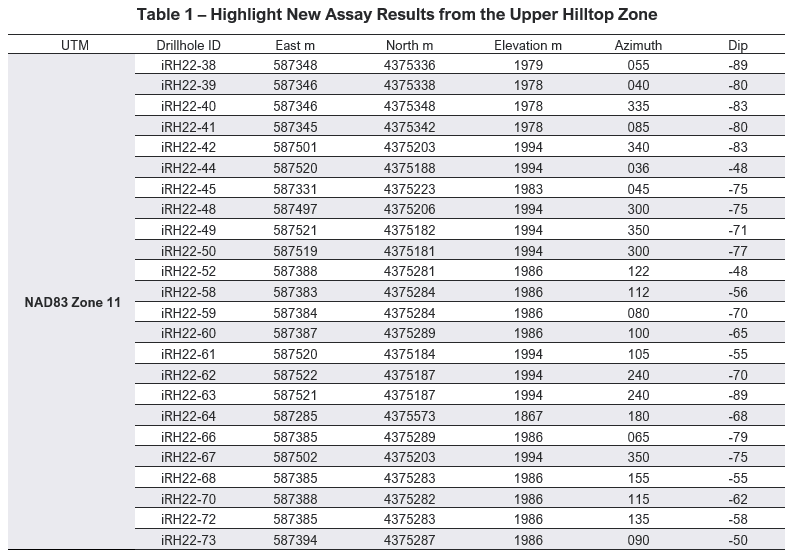
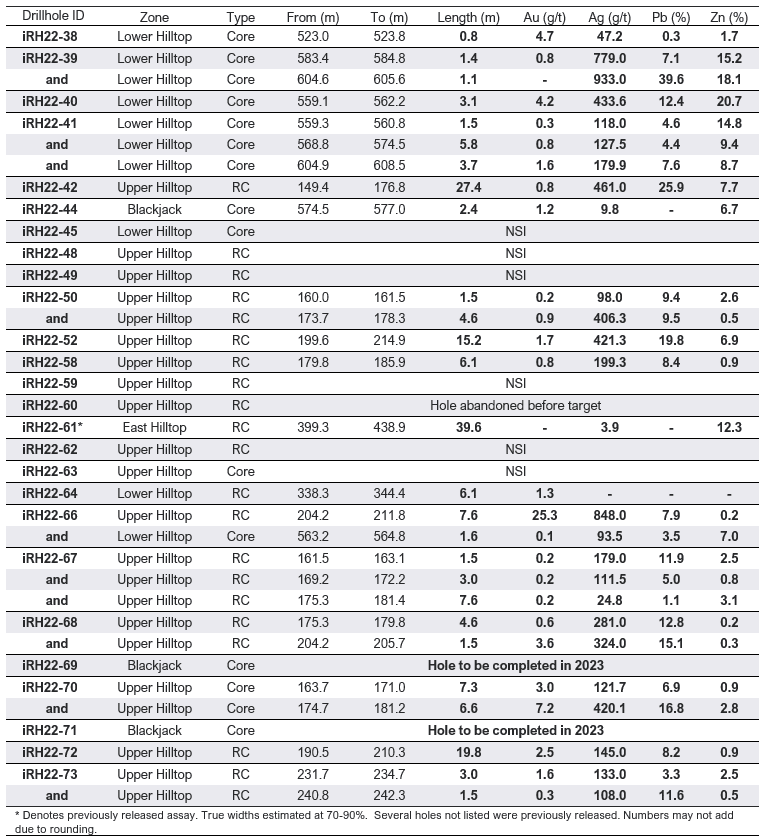
The Eureka (Ruby Hill) Mining District has a history of high-grade polymetallic CRD production that began in the 1860’s and spanned a period of more than one hundred years. Historic mined grades rank amongst the highest for any CRD district in the world. Since the 1960’s, the CRD potential of the Eureka District has been largely overlooked in favour of exploration for Carlin-type gold deposits and the Company considers the opportunity to be substantial. The Ruby Hill Property is one of the Company’s primary assets and is host to the core processing infrastructure within the Eureka District of the Battle Mountain-Eureka Trend including an idle leach plant, an active heap leach facility, and is host to multiple gold, gold-silver and polymetallic (base metal) deposits.
Multiple types of mineralization have been identified in the Hilltop Corridor including skarn (Blackjack), CRD (Hilltop/historic mines), distal disseminated Au-Ag mineralization (Mineral Point) and locally Carlin-type gold.
The Company has submitted for approval its plan to develop an underground mine at Ruby Hill with mineralization accessed via a ramp from the Archimedes open pit. Work is also progressing for the completion of updated mineral resource estimates (gold and polymetallic zones) and an initial economic study for the gold zones (only).
Ruby Hill Teach-in
The Company will be hosting a Ruby Hill technical teach-in on Thursday, February 23, 2023 at 12:00pm EST, to provide a detailed summary of geophysical survey completed at the Ruby Hill Property and the exploration plans for the property in 2023.
Microsoft Teams webcast and conference call details:
Date: February 23, 2023
Time: 12:00pm
Meeting Link:
Meeting ID: 264 885 958 845
Passcode: jBfzN6
Dial-in (audio only): 1-437-371-2618
Phone Conference Passcode: 319150803#
Please click here for further information on abbreviations and conversions referenced in this press release.
QAQC Procedures
All samples were submitted to ALS Minerals (ALS) of Sparks, NV, which is an ISO 9001 and 17025 certified and accredited laboratory, independent of the Company. Samples submitted through ALS are run through standard prep methods and analysed using Au-AA23 (Au; 30g fire assay; ALS) and ME-ICP61a (33 element suite; 0.4g Four Acid/ICP-AES; ALS). Overlimit samples of Ag, Pb, and Zn are analyzed by ore-grade methods comprising HF-HNO3-HClO4 Digest, HCl leach and ICP-AES. Additional samples overlimit ore-grade methods are analyzed by acid dissolution and titration. ALS also undertakes their own internal coarse and pulp duplicate analysis to ensure proper sample preparation and equipment calibration. i-80 Gold Corp’s QA/QC program includes regular insertion of CRM standards (gold and polymetallic), duplicates, and blanks into the sample stream with a stringent review of all results.
Qualified Person
Tyler Hill, CPG-12146, Senior Geologist at i-80 is the Qualified Person for the information contained in this press release and is a Qualified Person within the meaning of National Instrument 43-101.
About i-80 Gold Corp.
i-80 Gold Corp. is a well-financed, Nevada-focused, mining company with a goal of achieving mid-tier gold producer status through the development of multiple deposits within the Company’s advanced-stage property portfolio with processing at i-80’s centralized milling facilities.
For further information, please contact:
Ewan Downie – CEO
Matt Gili – President & COO
Matthew Gollat – EVP Business & Corporate Development
1.866.525.6450
Info@i80gold.com
www.i80gold.com
Certain statements in this release constitute “forward-looking statements” or “forward-looking information” within the meaning of applicable securities laws, including but not limited to, the expansion or mineral resources at Ruby Hill and the potential of the Ruby Hill project. Such statements and information involve known and unknown risks, uncertainties and other factors that may cause the actual results, performance or achievements of the company, its projects, or industry results, to be materially different from any future results, performance or achievements expressed or implied by such forward-looking statements or information. Such statements can be identified by the use of words such as “may”, “would”, “could”, “will”, “intend”, “expect”, “believe”, “plan”, “anticipate”, “estimate”, “scheduled”, “forecast”, “predict” and other similar terminology, or state that certain actions, events or results “may”, “could”, “would”, “might” or “will” be taken, occur or be achieved. These statements reflect the Company’s current expectations regarding future events, performance and results and speak only as of the date of this release.
Forward-looking statements and information involve significant risks and uncertainties, should not be read as guarantees of future performance or results and will not necessarily be accurate indicators of whether or not such results will be achieved. A number of factors could cause actual results to differ materially from the results discussed in the forward-looking statements or information, including, but not limited to: material adverse changes, unexpected changes in laws, rules or regulations, or their enforcement by applicable authorities; the failure of parties to contracts with the company to perform as agreed; social or labour unrest; changes in commodity prices; and the failure of exploration programs or studies to deliver anticipated results or results that would justify and support continued exploration, studies, development or operations.

